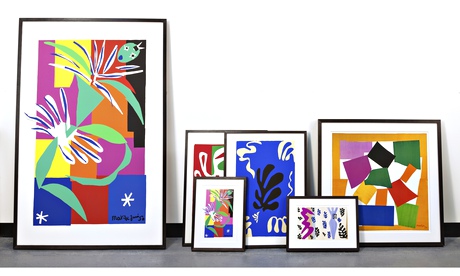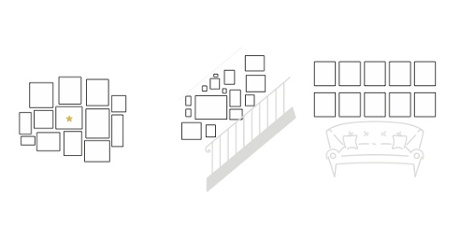
“It looks a little wonky,” says a friend, squinting at the Warhol print on my wall. “Wait! If I tilt my head slightly, it looks … OK.” I survey my (not so) handiwork and realise she has a point.
I am attempting a “gallery hang”, grouping pictures together. It turns out a successful display requires time, patience and a lot of research. After much research, trial and error – and relentless searching through interiors websites such as Remodelista and Design Sponge – packed with advice and inspiration – here’s what I learned.
Create cohesion
The trend to hang art all over the wall is referred to as salon style after the 18th and 19th century Parisian salons. It’s an attractive option because the viewer focuses on the collective effect rather than individual pieces. Start with at least five works.
I went for an old French movie poster, alongside photos of tattoos and some text torn from a magazine – all in a similar tone of blue; seemingly random elements with shared features will still feel cohesive. This style of hang also gives you the opportunity to play with scale. For instance, an enormous piece hung centrally will anchor any arrangement. No matter how randomly you position the smaller ones, it looks considered.
While clashing colours and tones will create a more energetic, vibrant mix, Francesca Gavin, who advises Soho House group on their art acquisitions, prefers mostly black and white: “We collect a lot of monochrome pieces,” she says. “Lots of humour, lots of hedonism, references to drinks and sex.”
Don’t wait around until you have the money to buy “real” art – postcards, posters, children’s drawings or pages taken from books can all look special by framing them or giving them a particular treatment.
Art doesn’t need to match its surroundings – contemporary pieces are often more striking in traditional settings and vice versa.
Choose the frames carefully
A varied collection of frames in one group is less restrictive and will prevent similar pieces from feeling static. “You don’t want the frame to outshine the art. Choose frames that enhance the work, and not something to match the furniture,” says Will Ramsay, founder of theAffordable Art Fair. “Then it’s no big deal if you fancy a spot of rearranging, the work will still look good no matter where you hang it.”
Work out the layout
Cut out templates to the size of each picture, and place on the floor to play around with different configurations. Aim for one central piece, progressing from large to small pieces as you move outwards towards the edge of the walls. For a salon hang, keep them fairly close together (2-3cm max) as more risks looking less coherent.
The temptation is to hang things high, but don’t. You should look down on the lowest picture in a group or within a space. Aim for about 145cm from the floor as a good average.
Be accurate
Tape the paper templates on to the wall with masking tape, and mark picture hook points. The experts at top framers John Jones advise you to be millimetre specific, rather than just scribbling in roughly the right area – a rigid ruler is best, so enlist help from a friend and use a tape measure.
Ben’s three favourite wall displays

1. The salon
The central frame is the focal point, and all the other works should be mounted spreading outwards away from the main piece. This is where you can really let loose with a mix of different artwork and frame styles.
2. The stairwell
The principal, focal artworks should follow your eyeline as you climb or descend the stairs. Then work outwards, filling the space around them with smaller pictures. Try to get a broad range of different-sized frames to add plenty of interest.
3. The geometric
Go for symmetry and precision. You should use the same size pictures, the same size frames, and measure the exact same distance between each one, and the top and bottom rows. This layout looks great hanging above a bed or sofa.
Source:The Guardian

Comments
Post a Comment
I would love to hear from you! Please leave your clouds of thought here :)